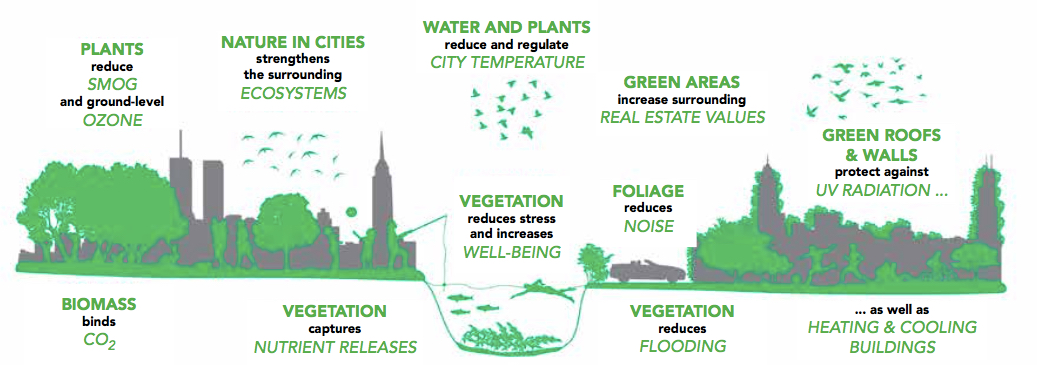Urban ecosystem services
Ecosystem services is a concept that draws attention to the dependence of people on nature. The term ecosystem services is perhaps new, but the concept is not. Municipalities are used to working with, for example, stormwater management and green spaces, but what is new and sometimes challenging, is working with the interactions between such initiatives. Through early cooperation in the planning process between different disciplines and stakeholders, green and blue structures can both help to solve challenges and contribute to creating healthy environments.

A city without ecosystem services is neither attractive nor alive. Creating, protecting and developing ecosystem services in urban areas can reduce ecological footprints while enhancing resilience and improving health and quality of life. By incorporating green spaces with plants and water courses, we can establish urban ecosystem services. Green-blue structures, the ground they rest on, and the animals, birds and insects that live there will provide us with the ecosystem services we need.
Greenery can help to regulate microclimates, clean the air and reduce noise from traffic, at the same time as providing places for recreation with exposure to nature. Greenery can be placed between buildings, on roofs or walls, or as trees along streets. Careful choice of plants, insect and bird feeders as well as proximity between green spaces can provide good habitats for pollinating insects and birds that disperse seeds. Permeable land, ponds and wetlands can take care of rainwater by levelling off the flow. Children who grow up in such environments are healthier and have a greater appreciation for nature.
Ecosystem services
Food: The ecosystem provides us with opportunities to grow food. Food comes primarily from agri- cultural ecosystems, but also from urban gardens. Drinking water: The ecosystem plays an important role in supplying cities with drinking water by taking care of water flow, storage and purification. Vegetation and forests affect water supply.
Species habitat: A habitat is a living environment for plants, animals or other organisms which includes the resources those species need to survive, for example food, water and protection. Every ecosystem provides habitats that can be critical for a species’ lifecycle. Some habitats provide for an especially large number of species so they are more genetically diverse than others (so-called “hot spots”).
Microclimate: Trees and green areas in cities lower the temperature, and forests affect precipitation and local and regional water supply. Trees can also shade streets and public squares.
Local air quality: Trees and other vegetation have a significant role in regulating air quality by absorb- ing air pollutants. Deciduous trees are efficient at cleaning air. In northern latitudes, coniferous trees can contribute to purifying air even during the winter.
Noise reduction: Noise in cities affects health, the ability of children to learn, and animal life. Trees and vegetation can reduce noise.
Binding of carbon and carbon dioxide: Ecosystems regulate global climate by storing greenhouse gases. Storage of carbon takes place when trees and other plants absorb carbon dioxide from the atmosphere and bind it in their tissues. Trees absorb carbon dioxide and give off oxygen.
Buffer for extreme weather events: Ecosystems have the ability to protect or reduce damage from extreme weather and natural catastrophes, for ex- ample downpours and floods.
Erosion protection and preservation of fertile soil: Plants can hold soil in place on slopes. Root systems bind the soil, while leaves and branches protect the soil from rain and reduce erosion.
Wastewater treatment and reduction of storm- water flows: Wetlands filter stormwater and releases. Through the biological activity of microorganisms in soils, sewage is biodegraded. Pathogens are removed and levels of nutrients and pollutants are reduced. Green spaces, both on the ground and on roofs, can absorb stormwater locally, which in turn reduces the load on water treatment plants during heavy precipitation.
Pollination: Insects and the wind pollinate plants that develop fruit, vegetables and seeds. Pollination is primarily carried out by insects, but birds and bats also play important roles in pollination and seed dispersal.
Biological pest control: Ecosystems are important for regulating attacks from pests and vector-borne diseases which attack plants, animals and people. Birds, bats, flies, wasps, frogs and fungi act as natural pest controllers.
Increased value of real estate: Research shows that housing in areas with trees and/or proximity to green areas have higher market values than in other areas.
Tourism: Ecosystems and biodiversity play a major role in tourism, which is important for many local economies.
Education: Outdoor play positively affects cognitive development and facilitates learning about nature and the environment.
Recreation, mental and physical health: Walking, sports and other physical activities provide exercise and relaxation. Green structures in cities play an important role in creating incentives for physical activity and reducing stress. They are essential for mental health and important for children’s development.
For green spaces to be used regularly and to provide the right conditions for active lives, they must be located close to homes or work, and be accessible by foot. The longer the distances from home or work to green spaces and parks, the fewer and the shorter the visits will be. Research has shown that 300 meters without roads or barriers is the limit for how far people are willing to walk.
A good green space promotes children’s psychological, social, physical and motor development. Spending a lot of time in green areas positively affects the ability of children to concentrate, they spend more time doing physical activity and are healthier. There are studies that show that children at pre-schools with good access to nature have better motor skills and concentration, fewer sick days and are healthier than children at pre-schools with poor access to nature.
